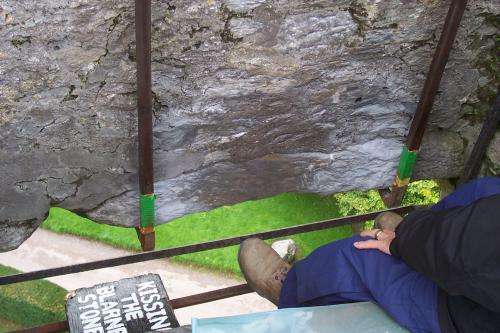March 18, 2014 weblog
Researchers claim to have found origin of Blarney Stone

(Phys.org) —A team of researchers at Scotland's University of Glasgow's Hunterian Museum believe they have solved the mystery of the origin of the famed Blarney Stone—it came from the area surrounding Blarney Castle in which it's held, they say, not Stonehenge or any of the other multitudes of places that have been suggested.
The Blarney Stone has become a part of modern populist culture—kissing it, legend suggests will impart the "gift of gab" which some contend extends to power of persuasion. For centuries it's been sitting in the battlements at Blarney Castle, near Cork in Ireland. To kiss it, those willing must hang upside down while holding onto iron bars placed for just that purpose. No one knows for sure where the stone came from, or how it got to where it is now, but theories abound. Some suggest it was hacked off a piece of rock at Stonehenge, others contend it was chiseled from the Stone of Scone. Some claim it has biblical origins.
This new piece of evidence came to light as an intern was cataloging thin slices of stone cut for examination under a microscope—held at the Hunterian Museum. It was marked Blarney Stone, which of course elicited immediate interest. Historians at the museum placed it under a microscope and found it to be made mainly of calcite along with crystalized fragments of ancient shells—all very nearly identical to the rocky area around where the castle is located, which means the stone was hewn locally, and thus virtually all of the legends surrounding it, are wrong.
The stone slice came to exist due to the efforts of Matthew Forster Heddle, a pioneer in using the microscope to study rocks in the British Isles during the mid1800's. How the slice wound up in Hunterian Museum, is still a mystery.
Despite the new evidence, it's not likely that legends of the Blarney Stone's origin will be put to rest. After all, there is still no conclusive evidence that the slice did indeed come from the Blarney Stone—there's just a simple label. There is also the emotional attachment many have with the castle and the stone inside, and of course, the possibly magical properties that a kisser of it may come to possess, that had to have come from somewhere.
More information: vie The Guardian
© 2014 Phys.org


















